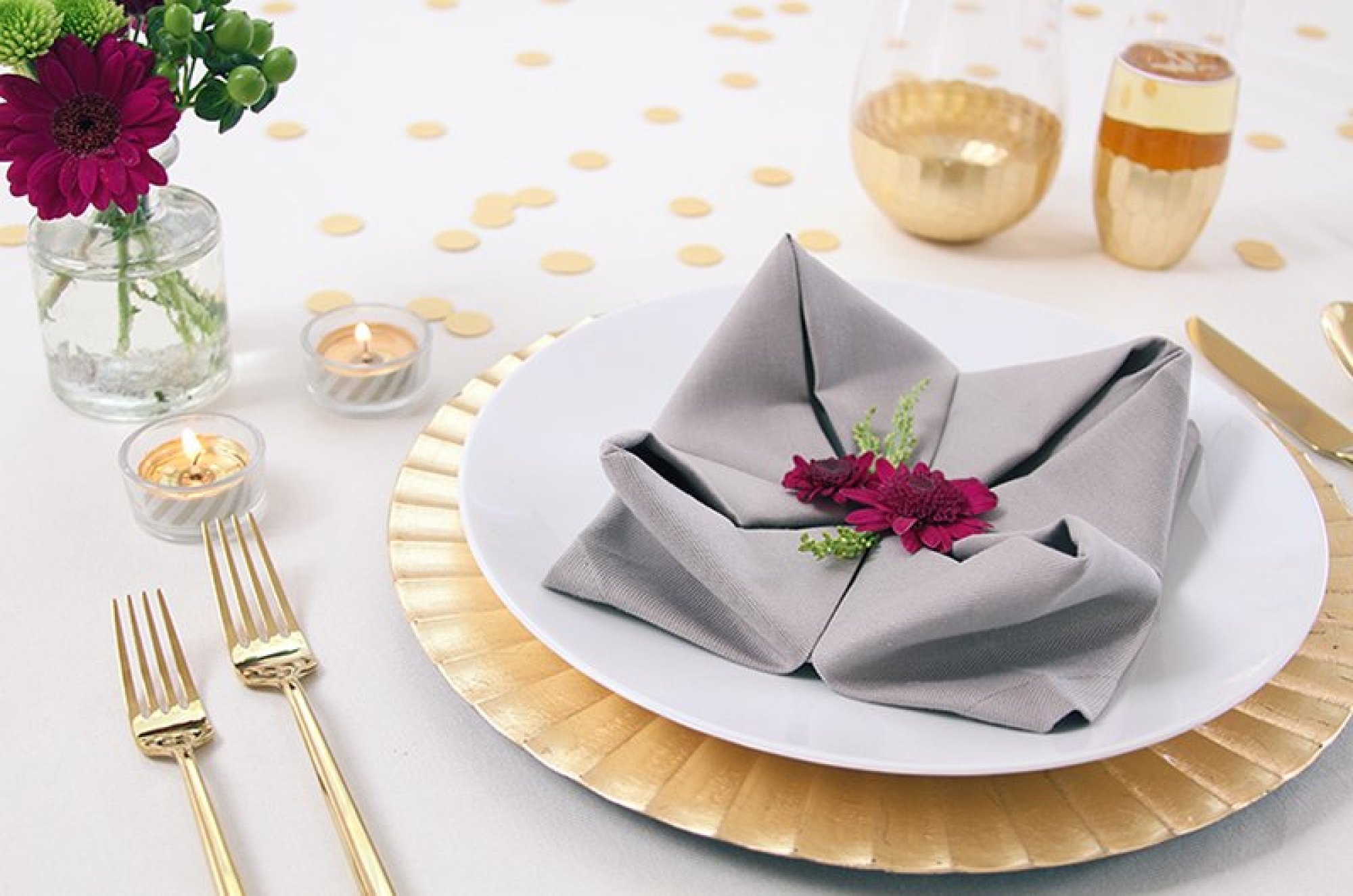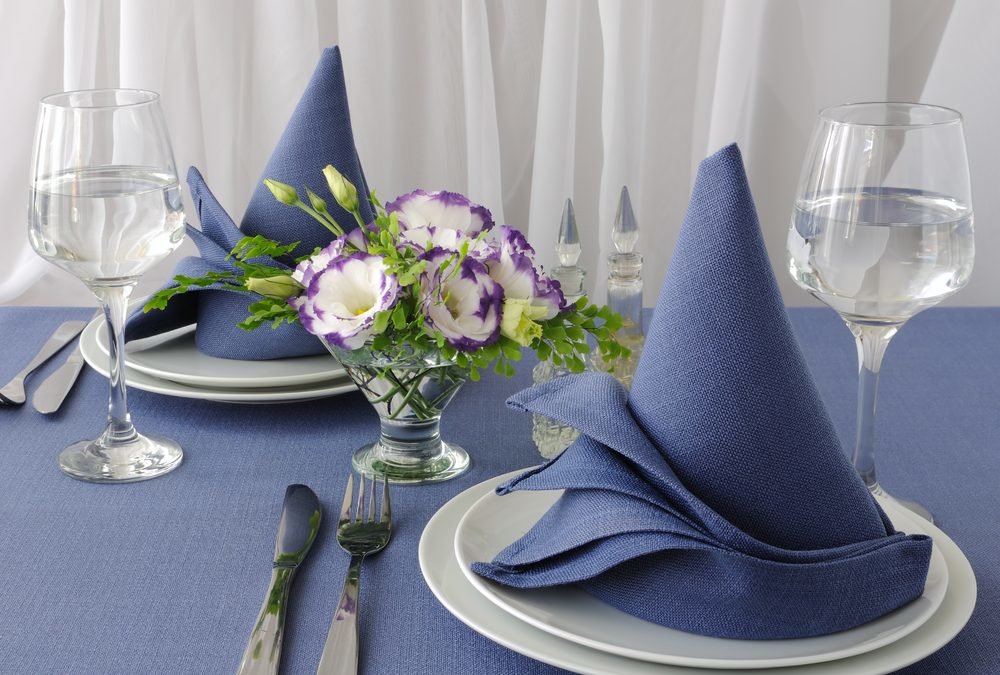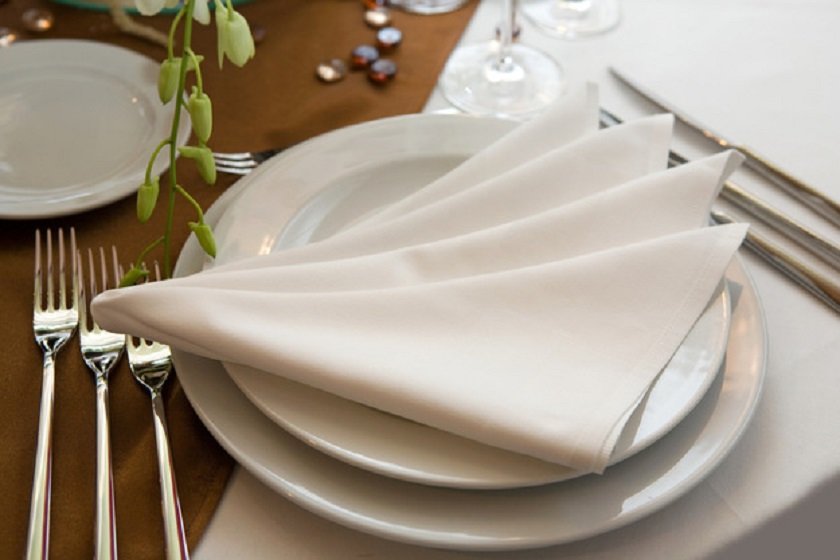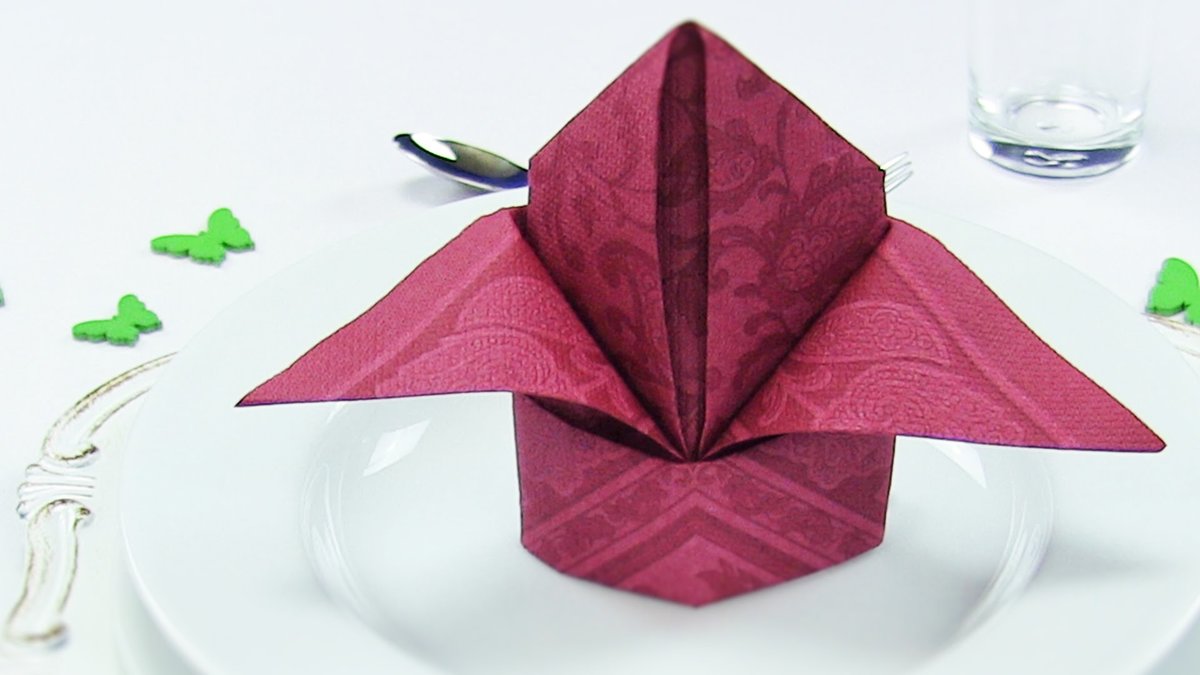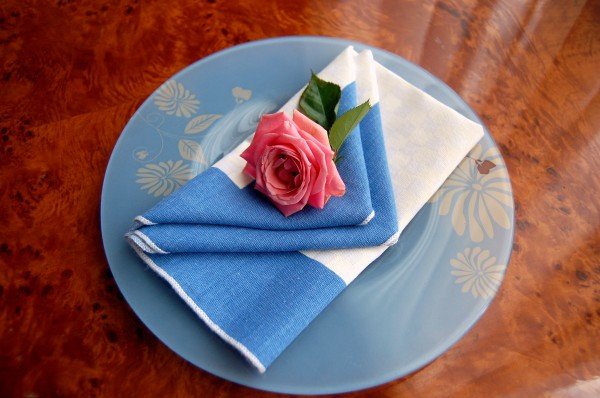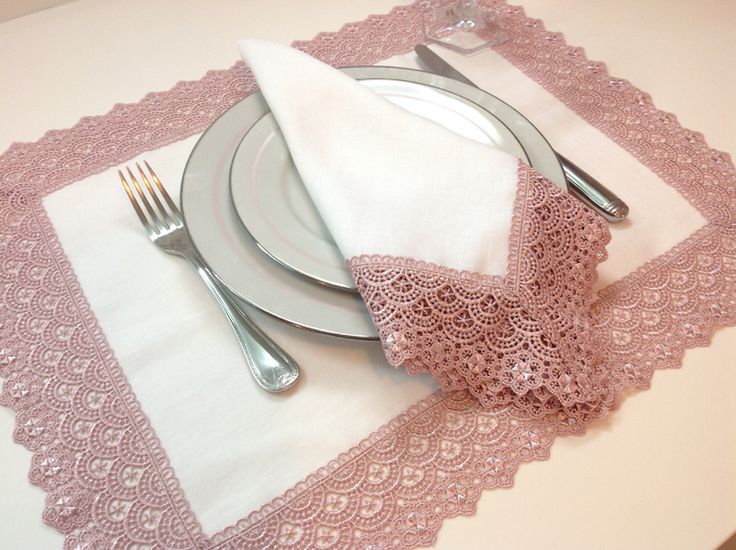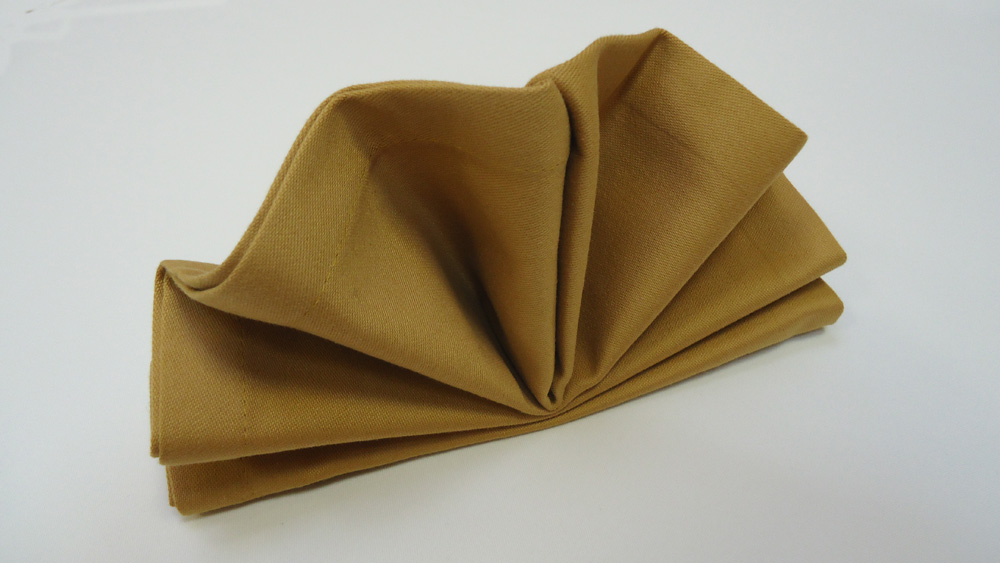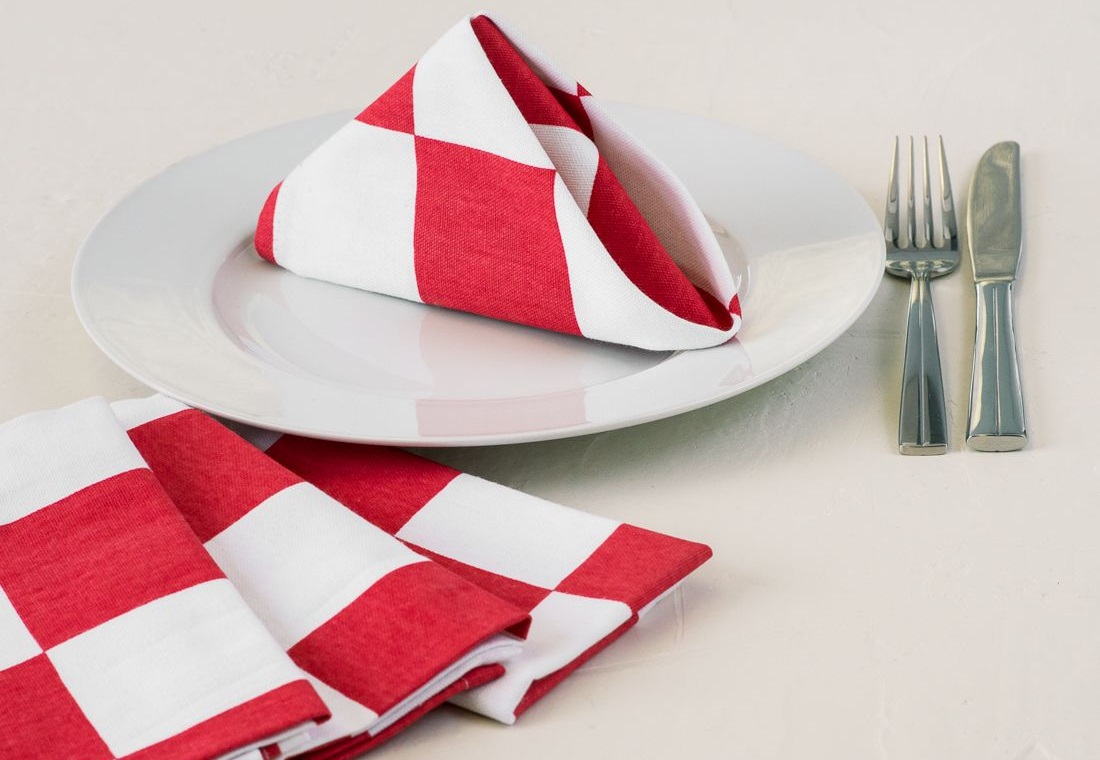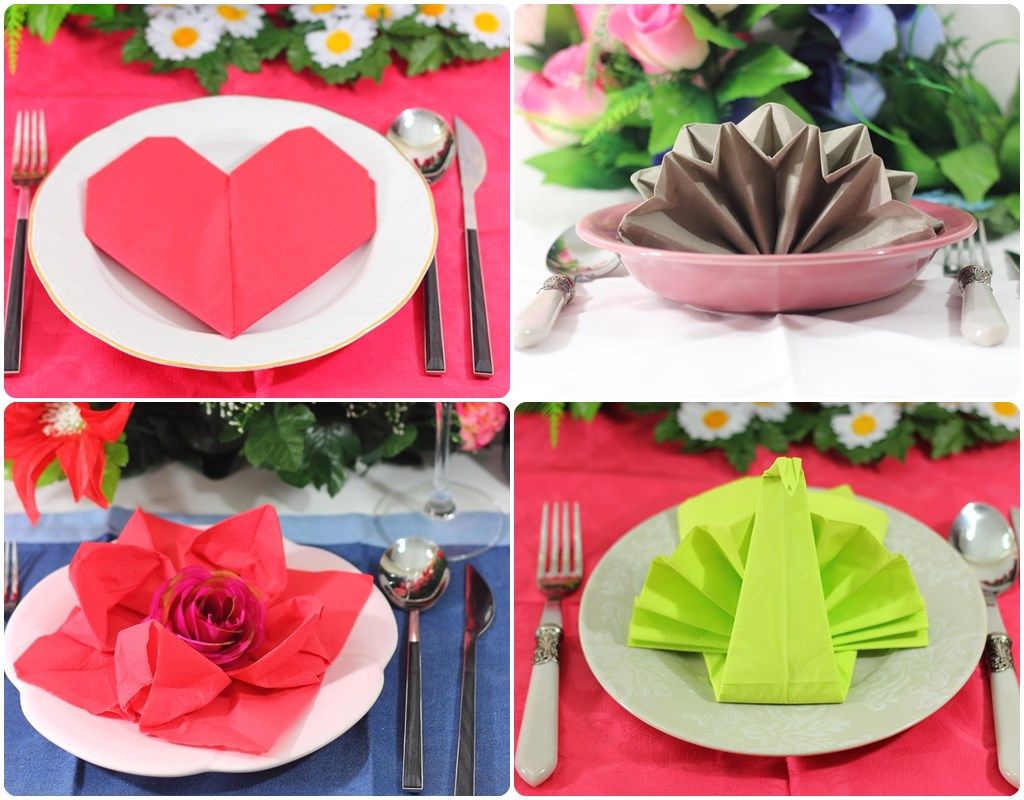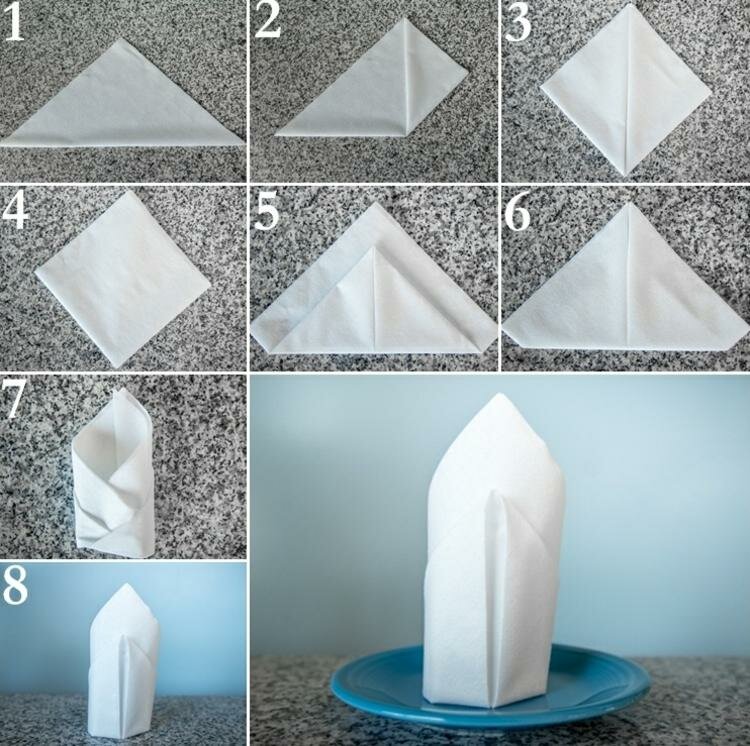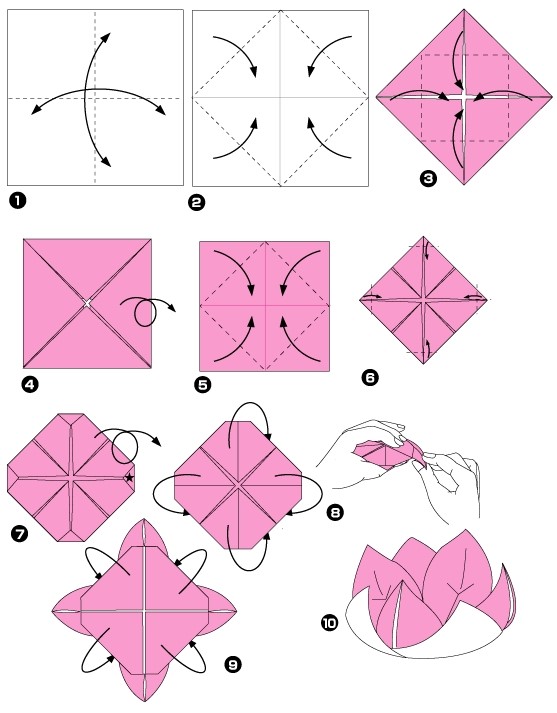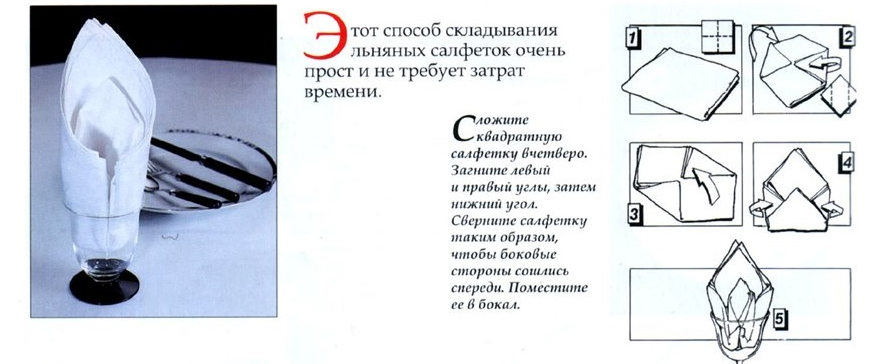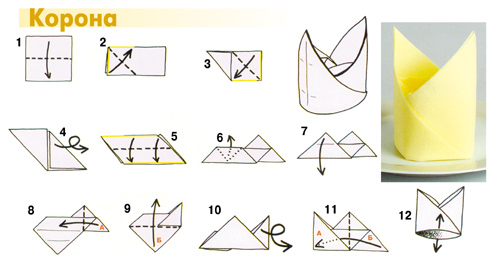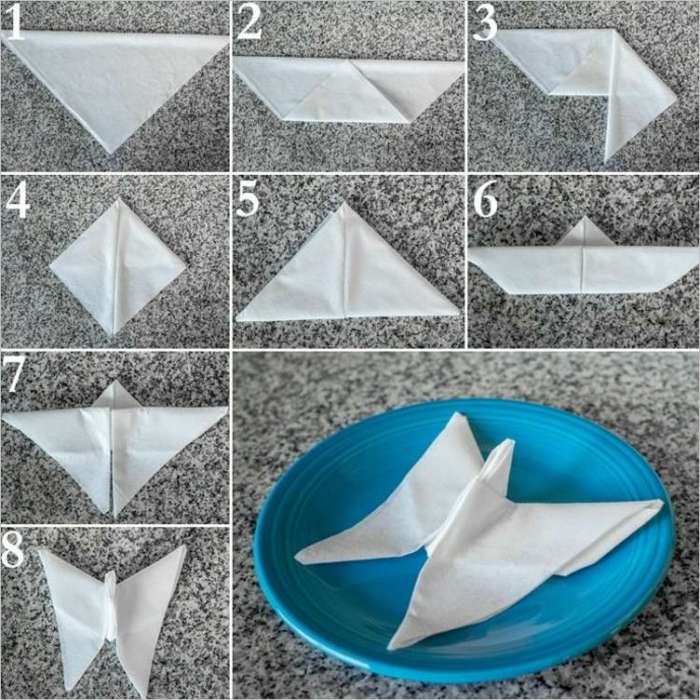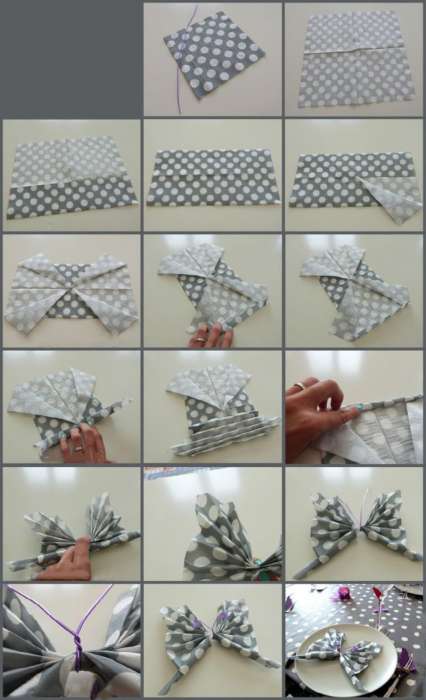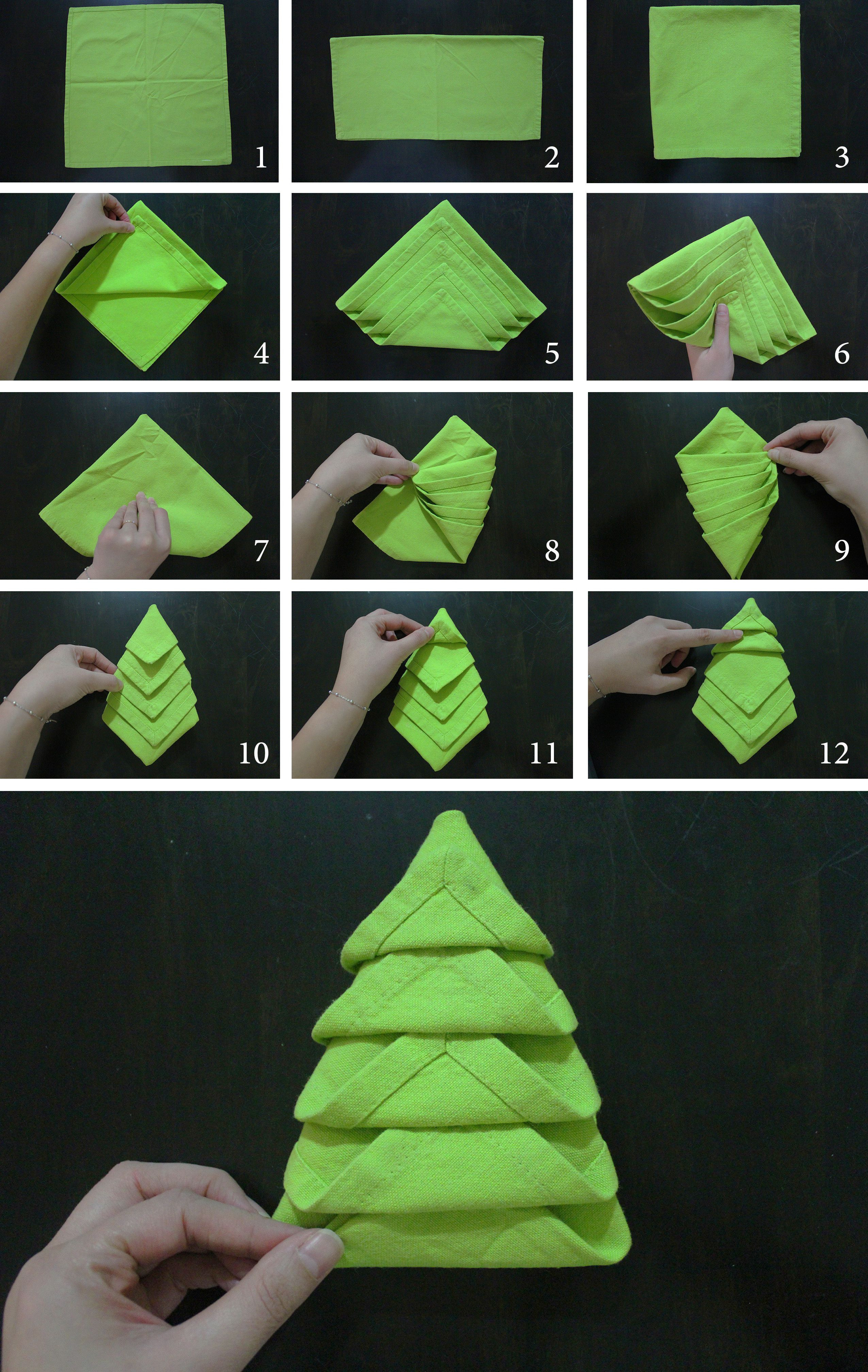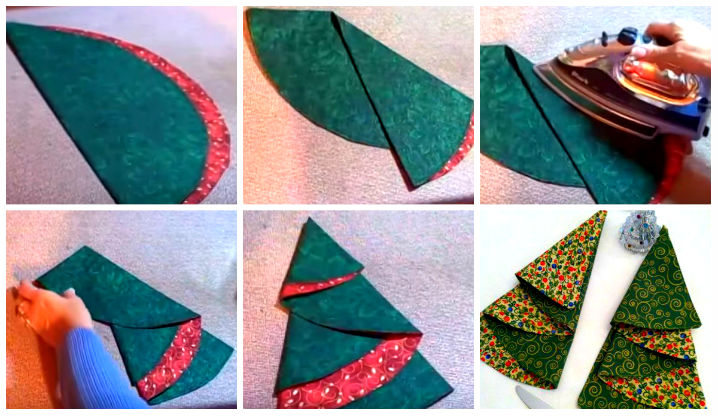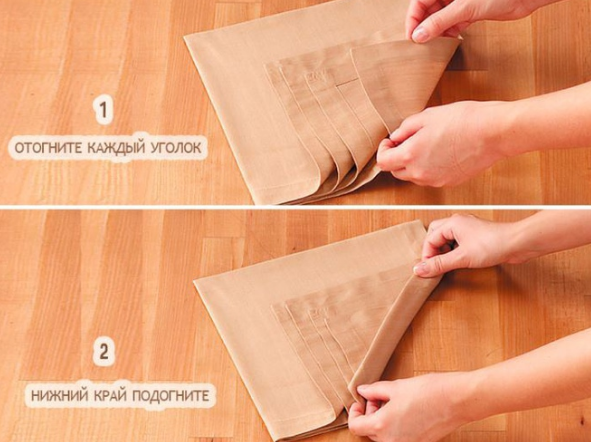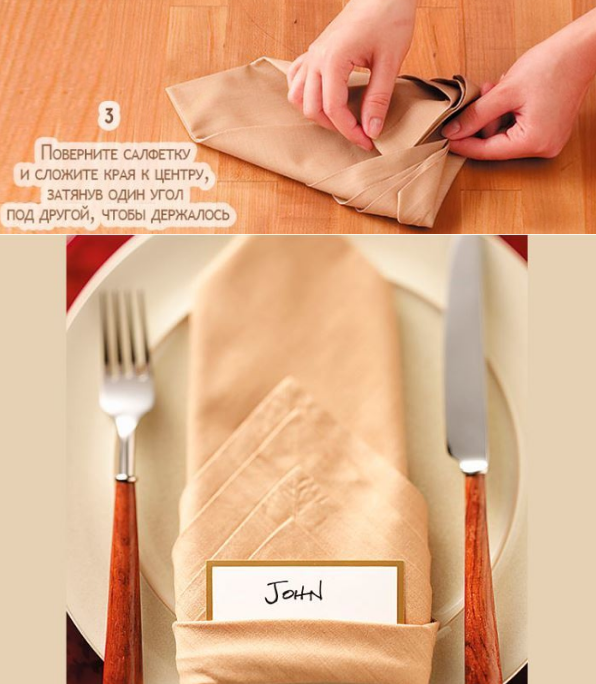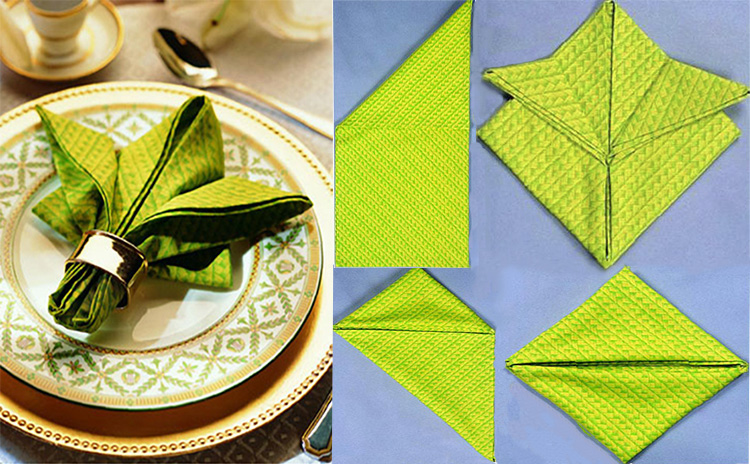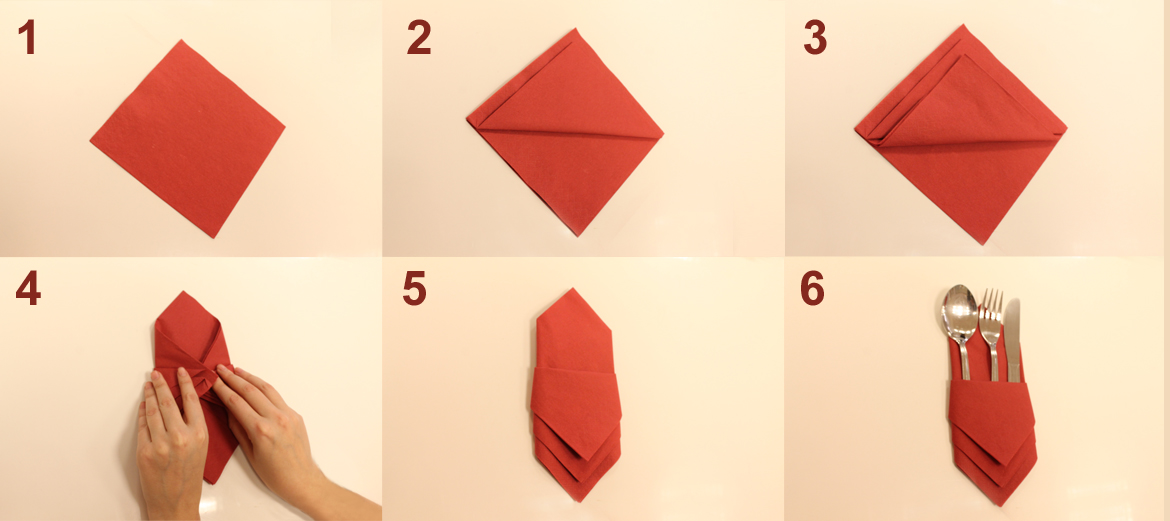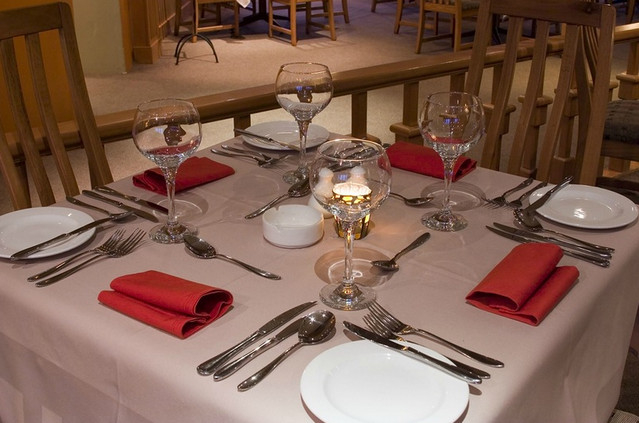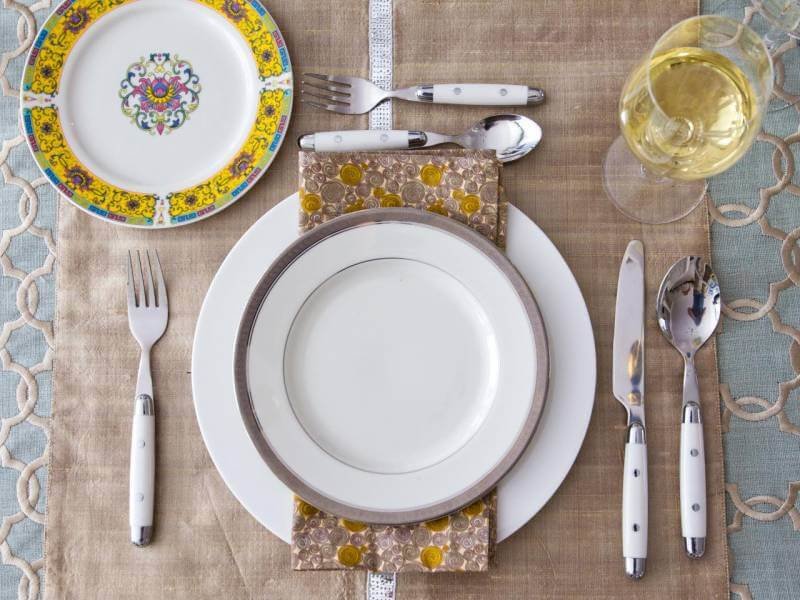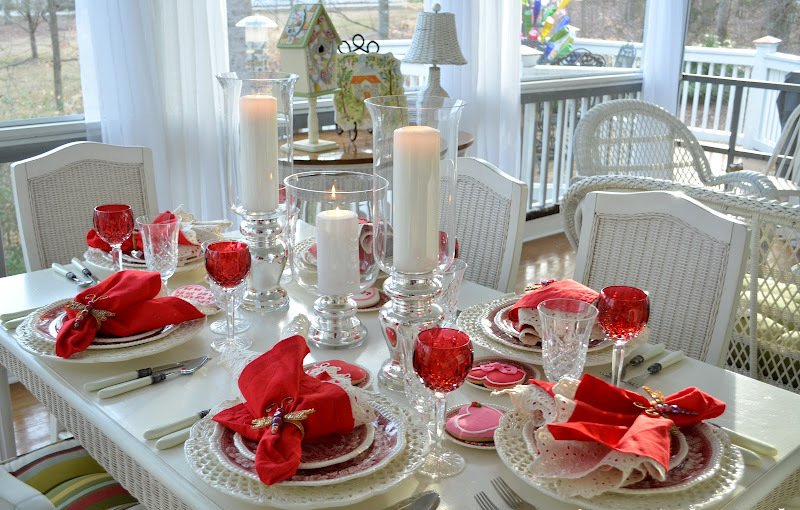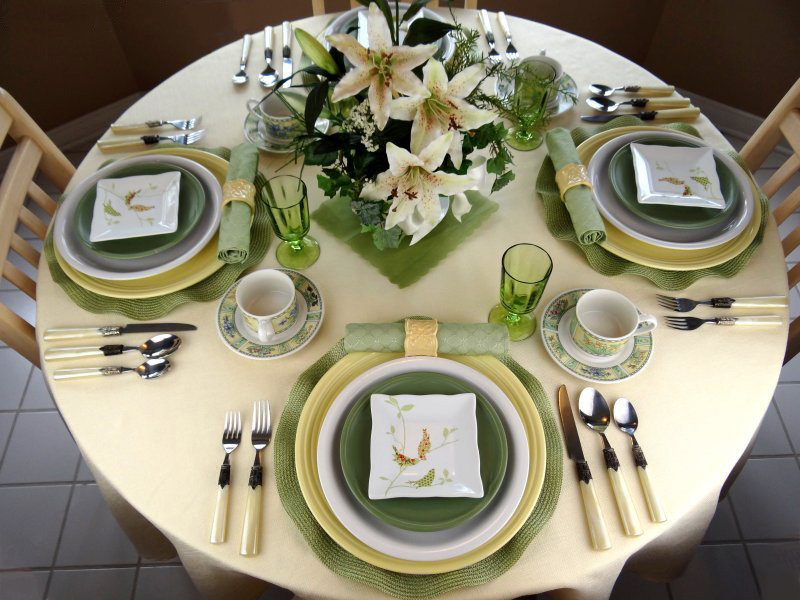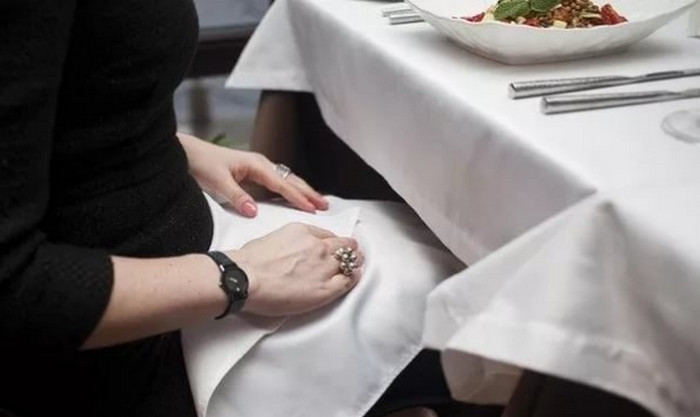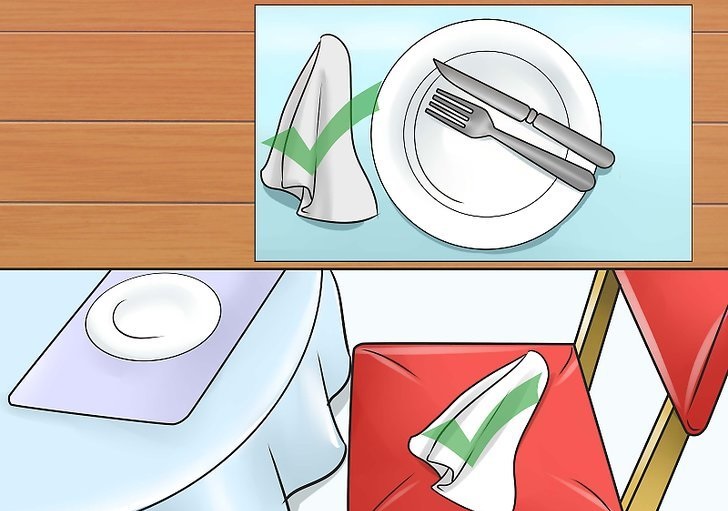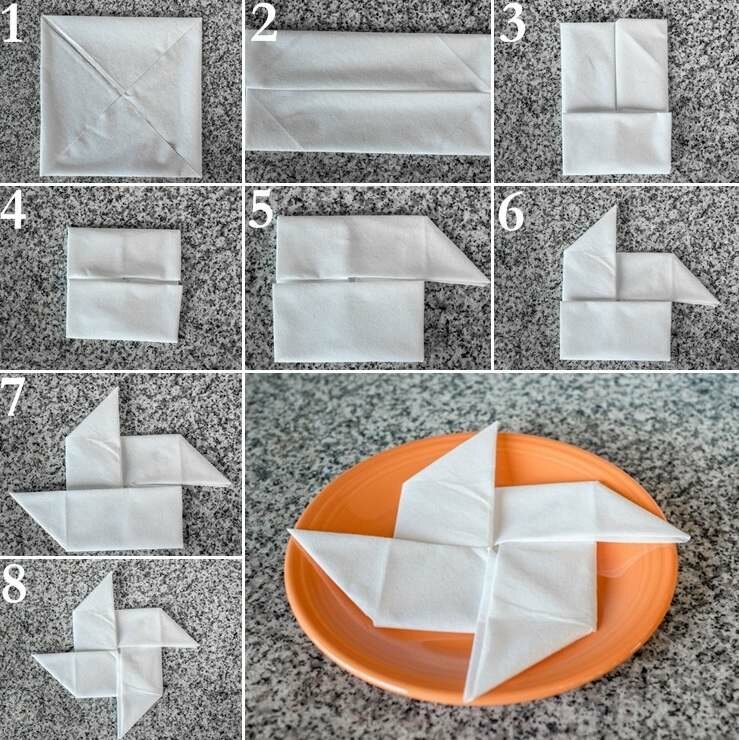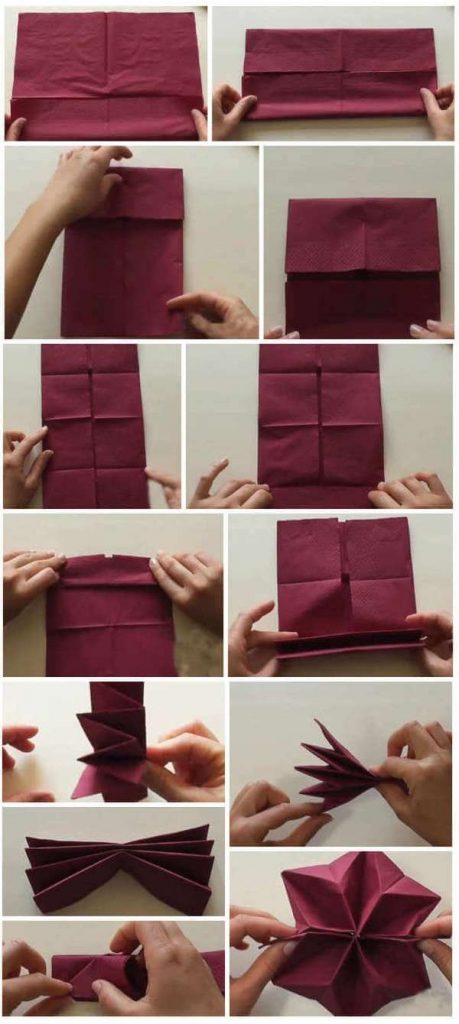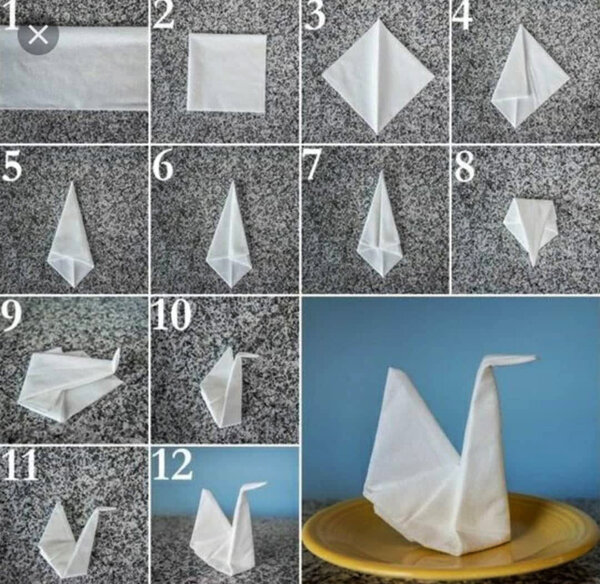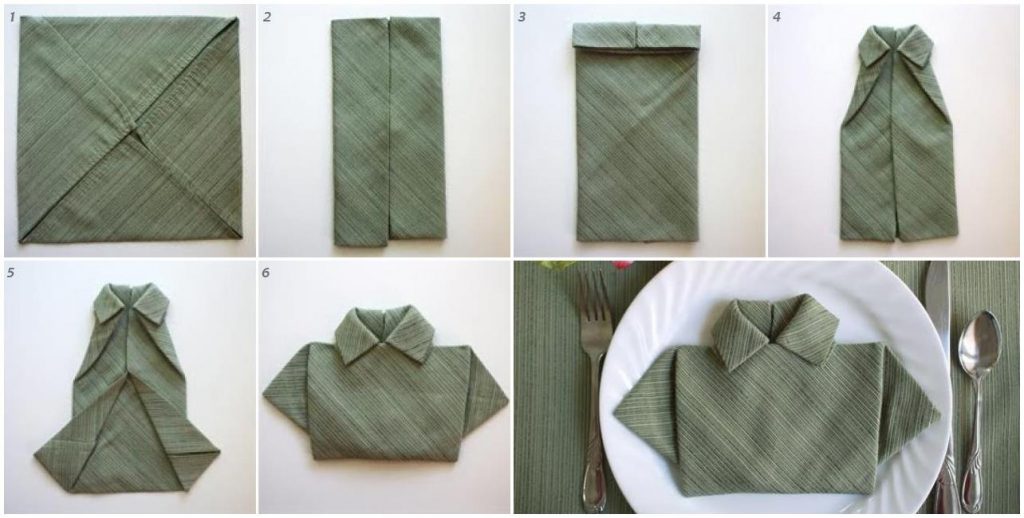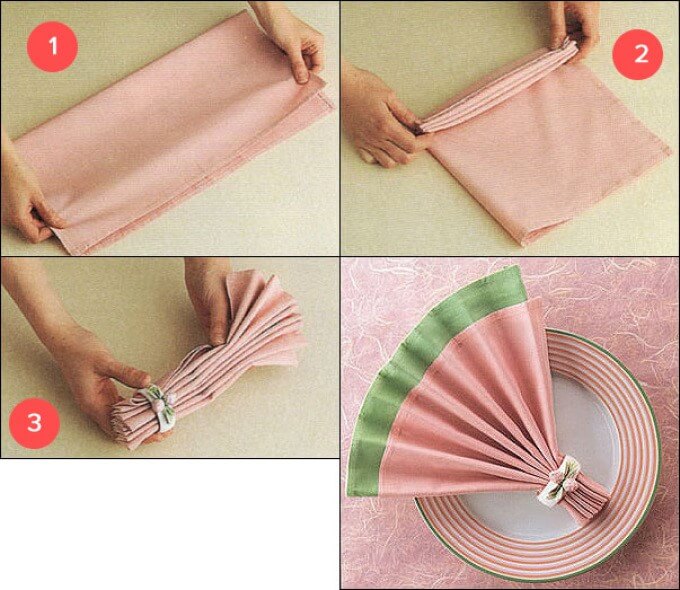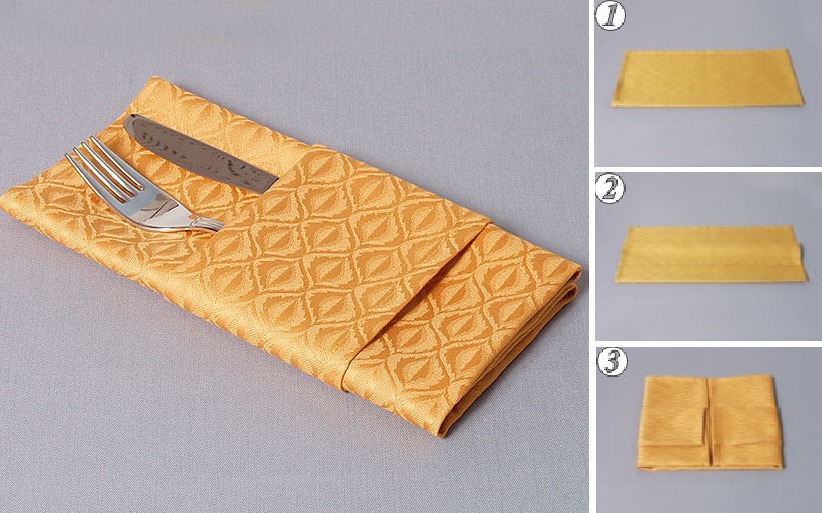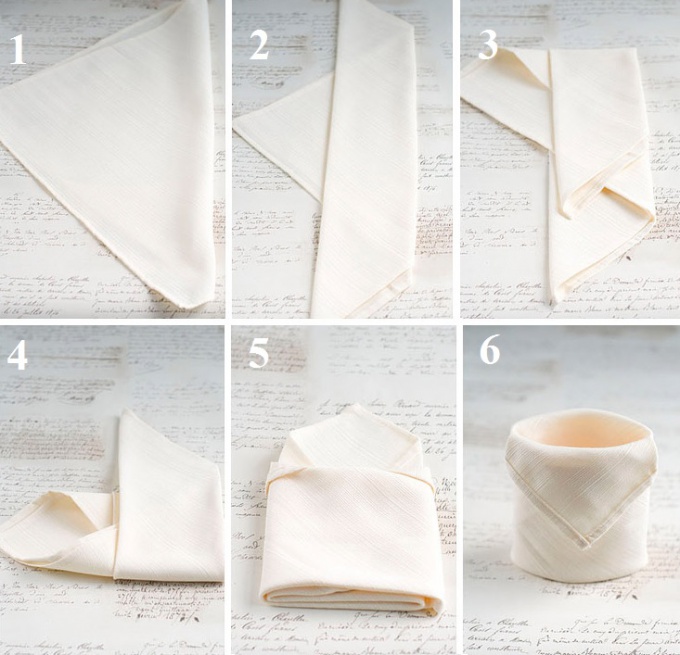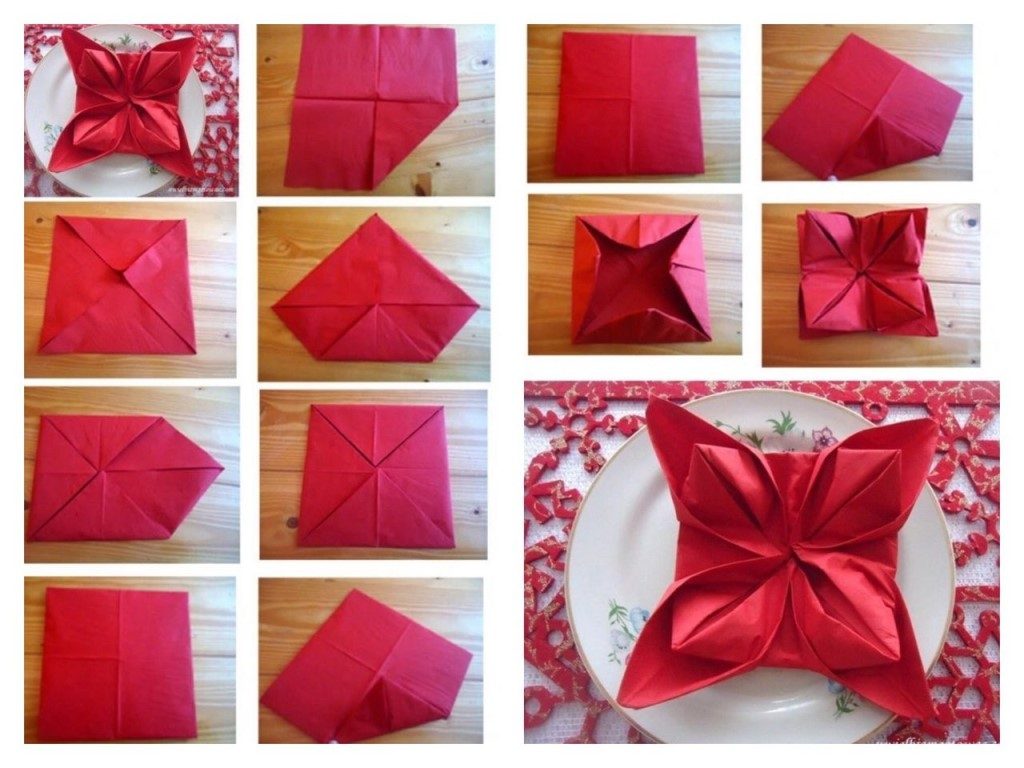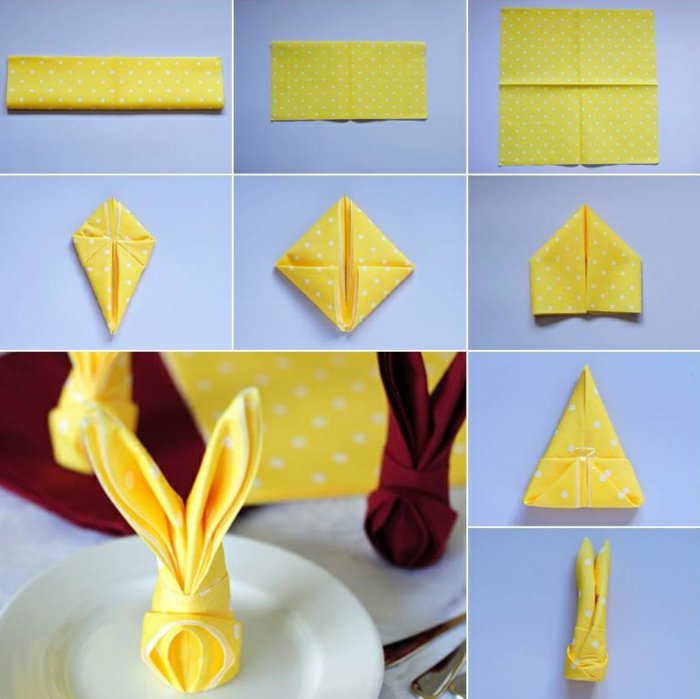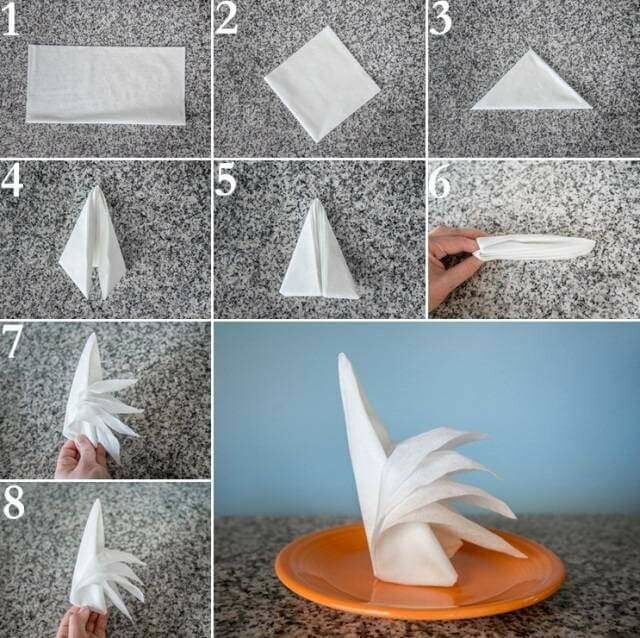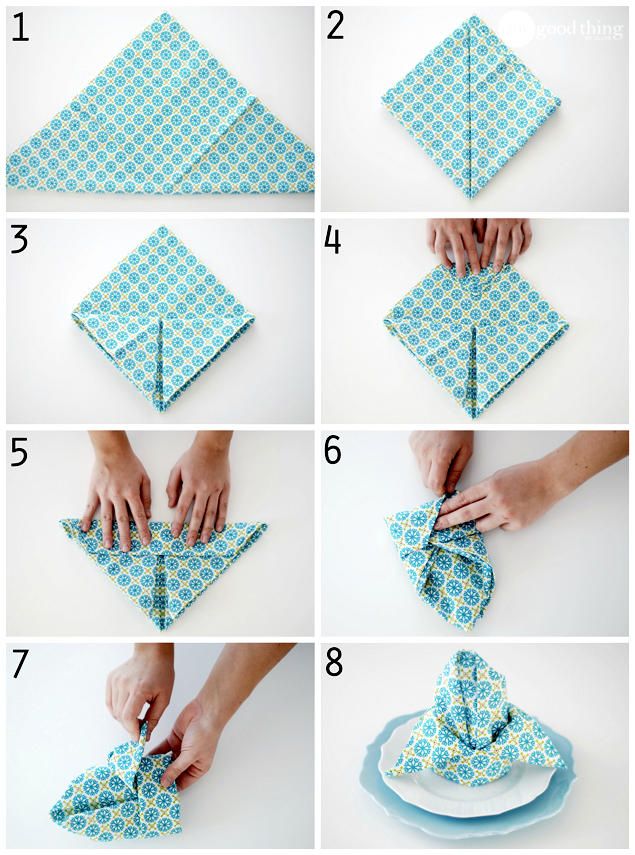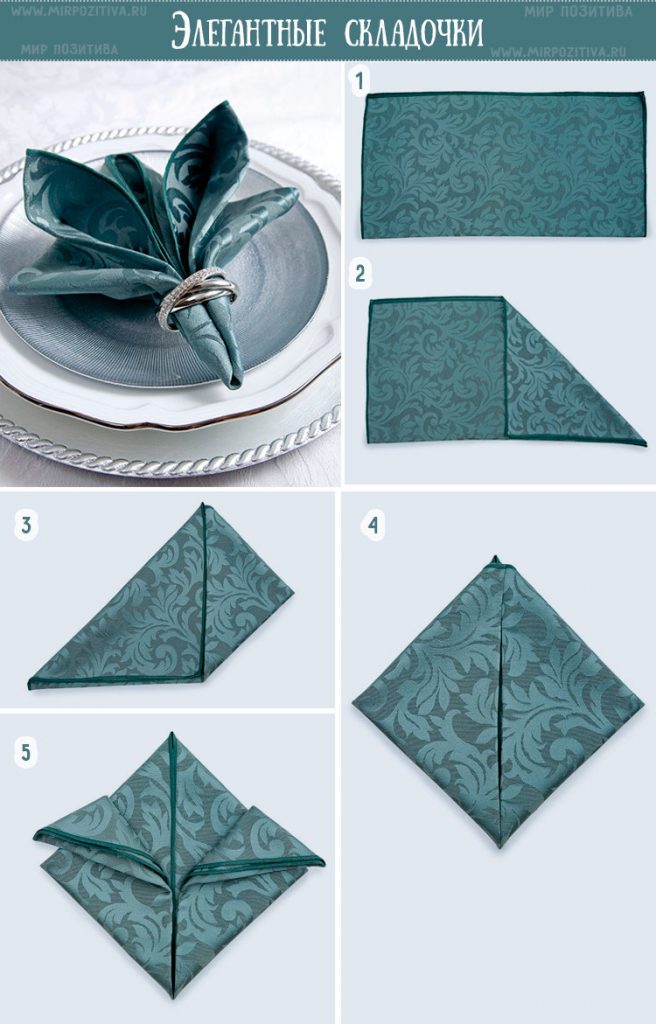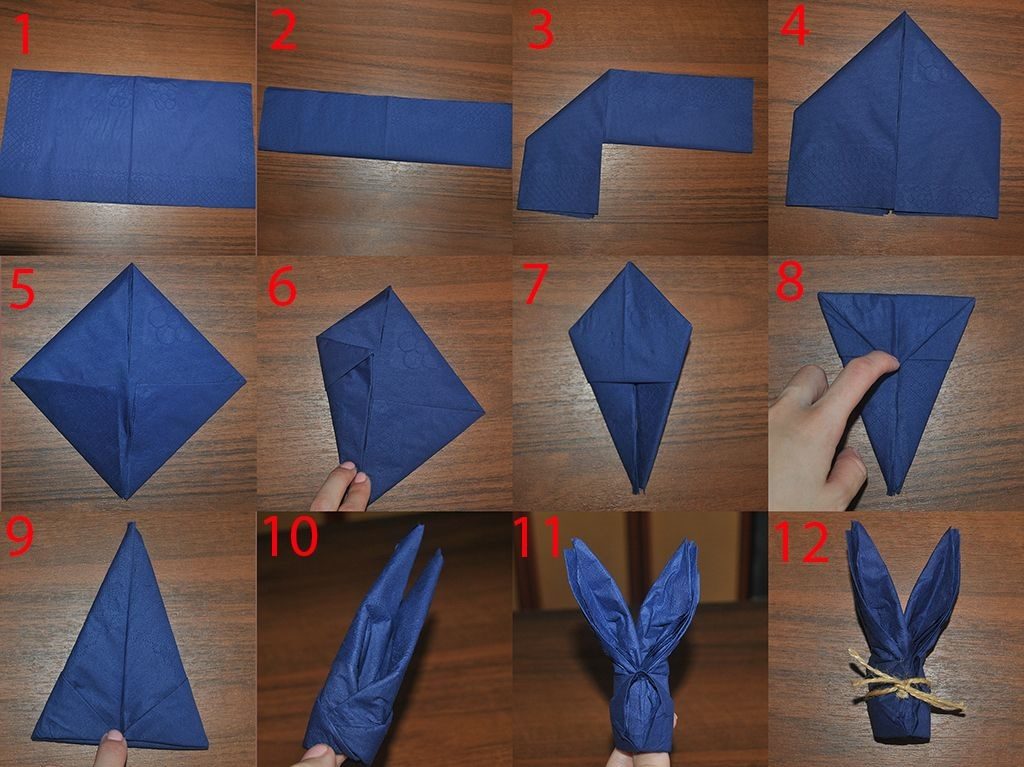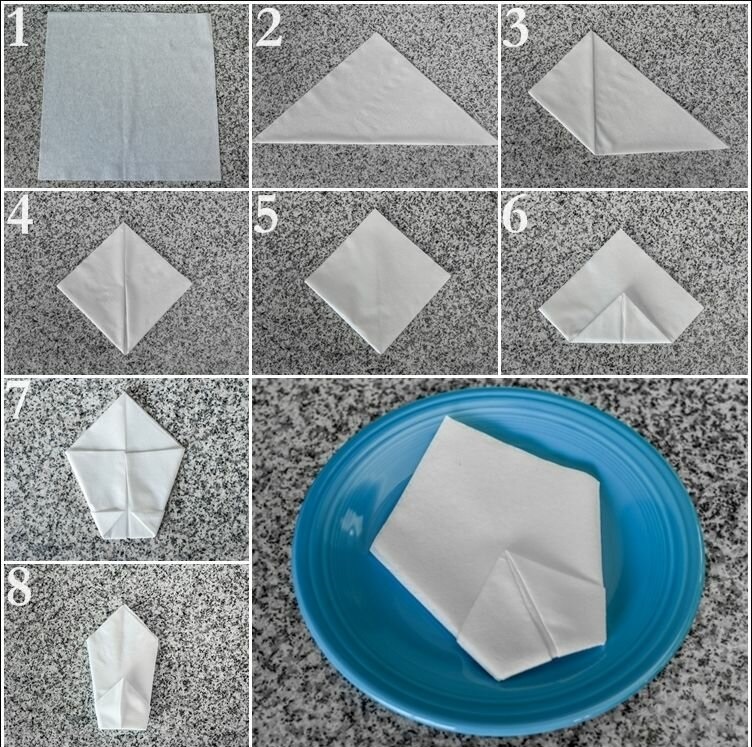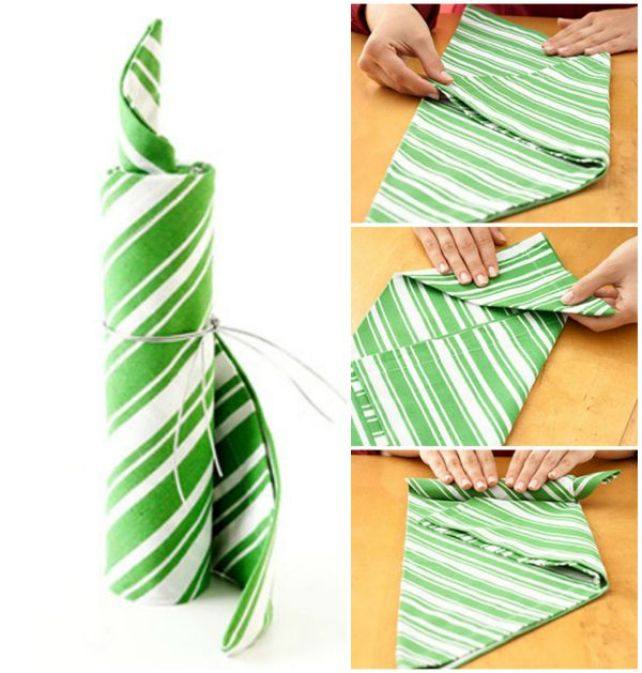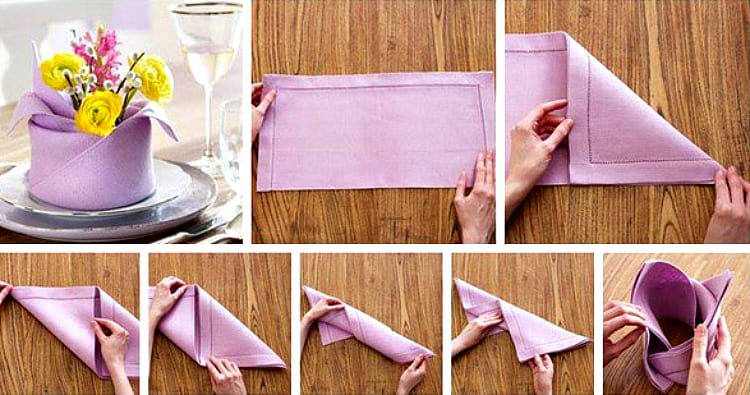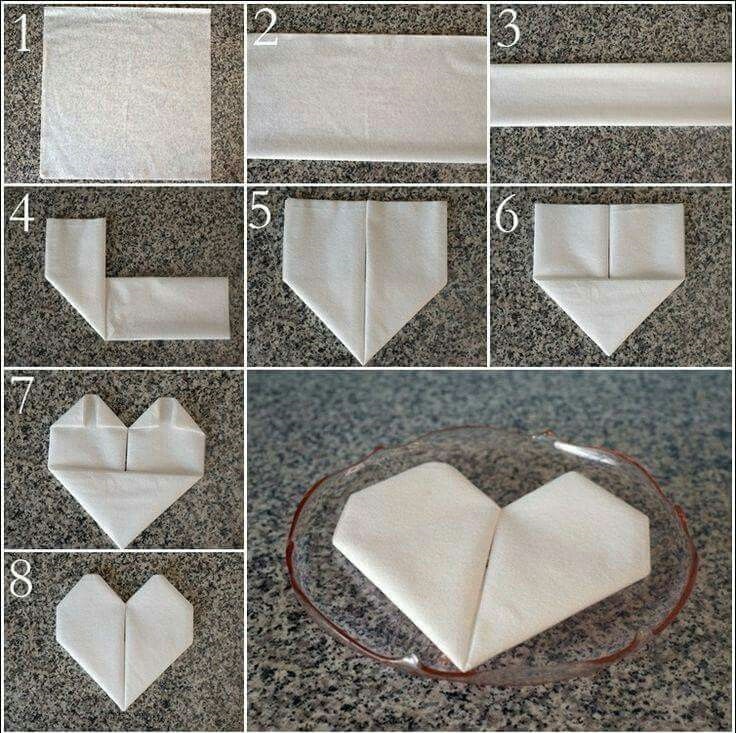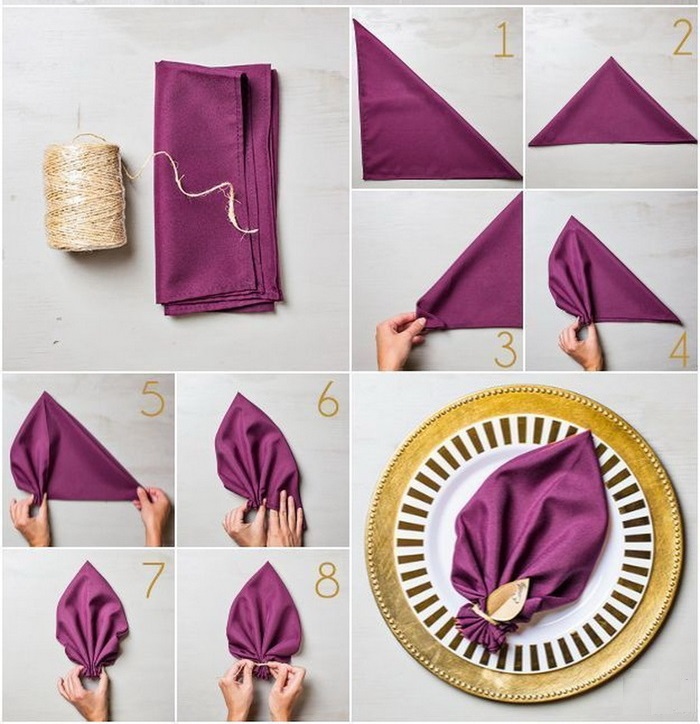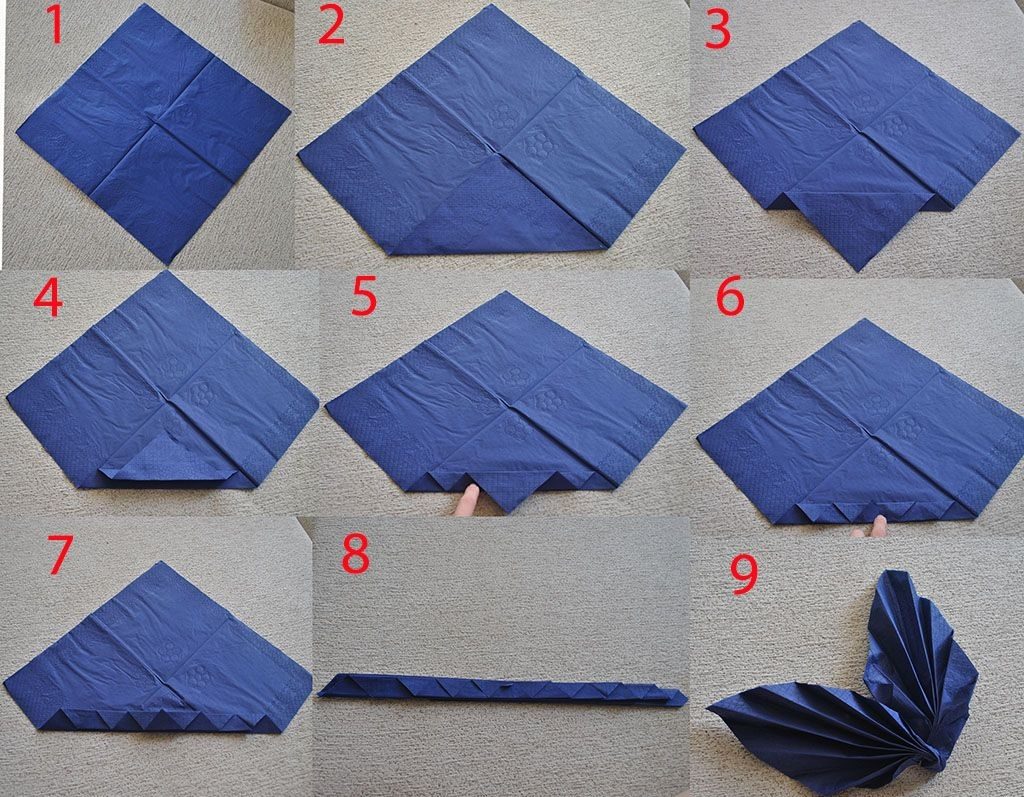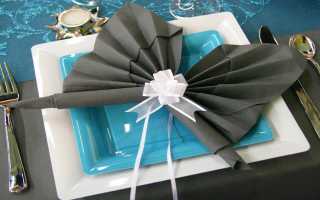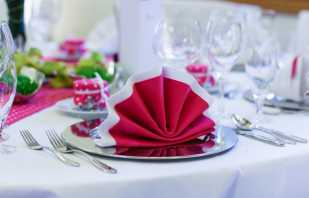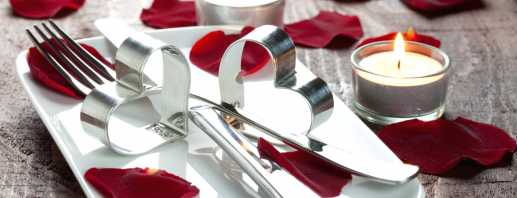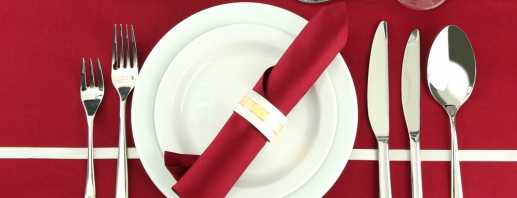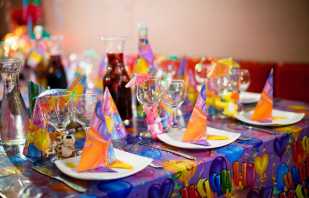Napkins for table setting, original folding methods
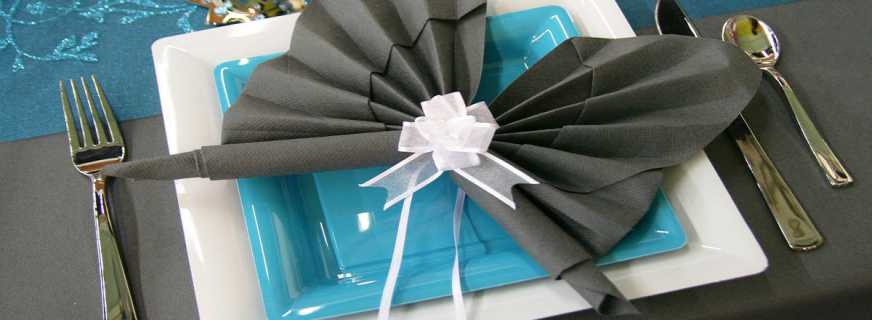
When laying the festive table, many underestimate the importance of napkins. With their help, you can create an unusual decor, arrange color accents, balance the combination of shades. Skillfully folding napkins for table setting is an art that can and should be mastered. Neatly made textile figures look favorably among ceremonial dishes, making the table even more attractive.
Content
Basic rules for using napkins in serving
To decorate the festive table using paper and fabric napkins. They perform an aesthetic and practical function. The color, size and folding options for napkins during table setting are selected depending on the degree of solemnity of the meal, as well as its type.
When serving is done, fabric napkins are folded onto the table in only one way. Paper is usually placed in a common napkin holder, and also placed under a plate for each guest on the right side.
For breakfast, simple forms are chosen. According to the rules of etiquette, it is recommended to fold fabric napkins for table setting four times, a triangle, an envelope, a tube. For lunch or dinner, it is customary to fold napkins in other ways, namely: with a cap, a crown, a hat. In preparation for the banquet, more complex methods of folding napkins are used, for example, in the form of flowers, a Christmas tree, a fan, a butterfly.
Varieties
Both linen and paper napkins are unequal in quality, color and size. Which products to choose depends on the particular case. The classic version for a formal dinner is table linen made of white linen. For informal situations - cotton and satin products of any color in harmony with the tablecloth. Modern fabric napkins are made from mixed fabrics. They do not deform after drying, iron well, do not sit down during washing.
Sometimes paper towels are allowed, but etiquette prefers fabric options.
The size of tissue napkins varies from 25 to 60 cm. Small square items with a side of 25, 30, 35 cm are suitable for decorating tea drinking, receptions, coffee, and dessert tables. Large, with side lengths from 60 to 80 cm, are taken to create complex shapes. Universal are linen squares measuring 50 by 50 cm. To create some figures, rectangular napkins are needed, but if there are none, then just fold the square in half.
To nicely fold fabric napkins for table setting, they must be starched. Slightly moist starched products are ironed, allowed to cool, and then immediately used for decoration.
Table textile cannot be starched in advance.During storage, creases are formed on it, which are very poorly smoothed.
Thin paper napkins are used during lunch with your family. On the festive table lay multilayer colored or white products. They are left whole or cut into triangles.
Popular folding methods
The options for folding napkins when laying the table are very diverse. Experienced craftsmen create complex designs from paper and linen squares. Those who are just starting to master the art of decorating choose simpler shapes.
Candle
The figure is appropriate during the New Year's feast or evening meal. Looks good in any color. Have "candles" on snack plates or in glasses. You can collapse the fabric in the form of a candle in the classical way, leaving its middle hollow, or in the original way, forming a “flame” or “wick” at the end.
Lotus
To create flowers from the fabric, the size of the napkins matters. The side of each square should not be less than 50 cm. The Lotus is folded from pastel-colored fabric and used for a wedding banquet or romantic dinner. Especially beautiful flowers look blue, pink, peach or lilac.
Tulip
This beautiful option is suitable for decorating a celebration of any level. “Tulip” is folded in two ways: on the leg, using 2 squares, or in the form of a cup - from one. The traditional shades for this figure are red, pink, yellow or orange - from pastel to bright, depending on the case.
Crown
For official banquets, this option is performed in white. For weddings and anniversaries - in gold or silver. Folded figures should be formed from squares with a side of 50-60 cm. This folding method looks impressive, but does not focus too much on itself. Ideal for table setting in honor of a man’s birthday.
Heart
To create this simple figure, they usually take red textiles. "Heart" is suitable for decorating a romantic dinner and wedding feast. This figure is often used for table setting on the occasion of Valentine's Day.
Fan
Looks equally good on a plate and in a glass. Depending on the chosen color, it will become a decoration of any event. Restrained tones are used for a friendly party, bright - for a children's holiday. This is one of the most versatile options.
Butterfly
When serving, use various options for folding napkins in the form of this figure. “Butterfly” is created from colored fabric or fabric with a small pattern. Usually such a figure is used for a men's holiday. If the culprit is a little boy, then you can take bright napkins, for a respectable gentleman, more strict tones will suit.
Herringbone
Suitable for a family New Year's feast and a festive banquet. The figure is made up of textiles of any color, in harmony with the dishes and tablecloth. An additional accent will be a shiny bead or wooden star on top.
With a place for a guest card
This method of folding the canvas is used at official receptions, where strangers are invited to each other. Also suitable for large-scale events (weddings or anniversaries) with a large number of guests. It can be made in 2 versions: a simple bag or in the form of an envelope.
With a napkin ring
One of the most beautiful ways to fold table textile. The napkin decorated in this way is folded in the form of a fan, a flower, a butterfly, and is used both on large feasts on the occasion of a wedding or prom, and at family celebrations. The option looks very original and elegant.
Under the appliances
The easiest way to fold woven items. Rectangular envelopes are made of textile squares, into which they put knives, spoons, forks suitable for this meal.In addition to the envelope, there are other types of figures for placing cutlery: a pocket in the form of a cone, a hexagon.
How beautiful to decompose
Table setting with cloth napkins depends on the type of meal, the number of dishes and the version of the linen figure. Etiquette allows the following methods of placing table textile:
- parallel to dessert devices, closer to the center of the table if the napkin is rolled up;
- in the center of the snack plate, if the table is set for a full dinner with a large number of plates, glasses and appliances;
- to the left of the hot plate (after the last fork), when the product is folded in a triangle, envelope or tube;
- in the middle of a small hot dinner plate in case there is no snack plate on it;
- between spoons and forks, if already filled dishes stand in front of the appliances;
- on the far edge of the serving plate, in the center of which there is a tea pair;
- in a glass (glass) to create a special atmosphere during a romantic dinner or themed feast.
To make linen figures organically look among other devices, they are placed on plates of small diameter, on average - 20 cm. Wine glasses and glasses for this purpose are taken high, with a volume of 300-500 ml. In the bowl of the glass the options “candle”, “tulip”, “fan”, “bouquet”, “horn”, “tower” look especially impressive.
Directly on the countertop, it is permissible to fold napkins in the form of a flat figure or tube. Sophisticated high options for jewelry made of textiles are placed only on plates or in wine glasses.
Etiquette of use
Napkins for a table made of fabric protect clothes from possible drops from dishes and drinks. In addition, they are applied to the slightly soiled fingertips and lips after each sip from a glass or cup. Etiquette categorically prohibits wiping sweat, lipstick, and badly soiled hands with a tissue. Do not use it as a handkerchief, wipe textiles with cutlery, glasses, and a telephone. There is a paper counterpart for this.
A tissue napkin is used in the following sequence:
- The rolled-up cloth is taken in a pinch and shaken, keeping your hand away from the dishes. At a home dinner party, the hostess (and if her master is absent) is the first to unwrap the napkin at home. In a restaurant, the first to do this is a woman. If only men are at the table, then the inviting party takes the textile product first. This gesture is a signal to the beginning of the meal, now guests can unfold fabric figures. In the restaurant, the napkin is deployed only after serving the first course. When they make an order and drink an aperitif, they don’t touch it.
- Now you need to fold the napkin in half. In this form, it is placed on its knees with an open edge to itself.
- During the meal, fingers are wiped with a half lying on top, without removing the product from the knees. To wet lips, the upper edge of the square is turned inward by 5–7 cm, the matter is lifted to the mouth in an expanded form, holding it by the fold, and then returned to its knees with the clean part down.
- When all the dishes have been eaten, the woven square is taken at the center and placed on the left of the plate on the table.
If you need to temporarily leave the table, put a napkin on a chair. This is a signal that the guest has not finished eating and will return. If a textile product has slipped from its knees, they do not lift it, but ask the hostess or waiter to bring a clean one.
If table setting with tissue napkins is not expected, use paper counterparts. With a large square, they perform the same actions as with a linen product. A small paper triangle is folded with its top towards the base, and then doubled, and removed under the edge of the plate. As necessary, they take it out, wipe their hands and mouth with the inside, then fold it again and return it to its place.
According to etiquette, each time you need to take a clean paper triangle, and fold the used one and place it under the edge of the plate. After eating, dirty napkins are placed on a plate.
Folding napkins for table setting should be given no less attention than the selection of dishes and decorative elements. Beautifully folded textiles will make even a modest feast more status.

